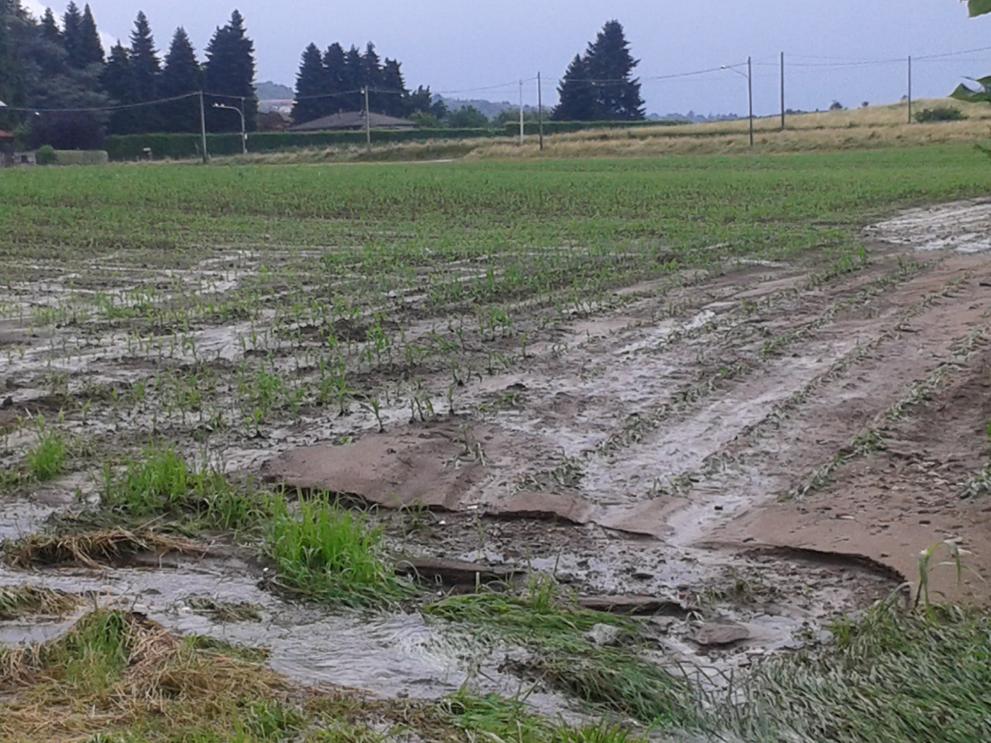A
first-ever assessment at European scale combines the threat of water, wind,
tillage and harvesting to reveal the cumulative impact on arable land. It is a
basis for developing a comprehensive monitoring system for soil health

Soil erosion is a serious threat to
soil functions leading to land productivity decline and multiple off-site
effects.
New analysis using a
multi model approach assesses impact of soil erosion not only by water but by
other drivers: wind, tillage conditions and crop harvesting. The study indicates that 43 million hectares
(M ha) out of approximately 110 M ha of arable land in the EU and the UK are
estimated to be vulnerable to a single driver of erosion, 15.6 M ha to two
drivers and 0.81 M ha to three or more drivers.
About 3.2 M ha of arable
land are vulnerable to the possible interaction of increased flood, drought,
water, and wind erosion. The analysis, carried out by JRC scientists and EU Soil Observatory
Working Group on Soil Erosion, is published in Nature
Sustainability.
Worldwide, very few
national survey programmes of soil erosion exist, examples being the US National Cooperative survey and the
Chinese National General Survey Program on Soil and Water Conservation.
In EU, Land Use/Cover Area frame Survey (LUCAS)
is the de facto soil monitoring system that collects data on gully erosion. The
set of predictions used in this analysis serves as a basis for developing an
efficient stratified monitoring network and informing targeted mitigation
strategies under the Common Agricultural Policy 2023–2027.
The multi model approach
provides estimates of gross soil displacement (soil moved annually from their
original location without considering soil deposition).
As for individual
processes, soil displacement by water erosion is dominant both quantitatively
(51% of the total displacement) and spatially (57% of the total area). Soil
displacement due to water erosion in the EU is estimated to be equal to a 1 cm
displacement of soil annually from an area twice the size of Belgium.
Tillage erosion is the
second-largest driver of soil displacement with an estimated share of 36%,
followed by wind erosion and crop harvesting accounting for 10% and 2.7%,
respectively of the total displacement.
The role of soil
Healthy soil is the
foundation of agriculture and ecosystem functioning. Changes in soil quality
affect provision of food, water supply and regulation, and carbon
sequestration. Good soil is a major microbial gene pool from which we extract
biomedical resources – lower soil quality puts in question this process.
Soil erosion is a serious
threat to soil functions leading to land productivity decline and multiple
off-site effects. It reduces soil stability, alters soil structures, impedes
soil biology, reduces water holding capacity, leads to a loss of soil nutrients
and potentially reduces soil organic carbon pools, therefore impairing all
major functions of soil, not only its productivity.
The ephemeral nature of
erosion makes prediction and monitoring to allow for a proper risk assessment
and policy mitigation quite challenging. While recent modelling has been
transformative in informing policy, it has been restricted to single process.
The new analysis uses a combination of models to present a novel assessment of
the spatial distribution of the combined (additive) threat of four soil erosion
processes (water, wind, tillage and harvesting) across arable land in Europe.
Impact of soil
conservation policies in EU
The study highlights
actions for reducing erosion, such as increasing vegetation cover on arable
land throughout the year and reducing tillage intensity. These actions are
beneficial to the functional agrobiodiversity of the farming system.
For this concern,
soil-conservation standards, related to the Common Agricultural Policy (CAP),
integrated in the cross-compliance mechanism are considered as relevant. Good
Agricultural and Environmental Conditions (GAEC), defined at national or
regional level, include a set of standards especially on minimum soil cover and
soil minimum land management to limit erosion.
The modelling approach by
JRC scientists and the co-authors of the analysis shows that – compared to a
pre-CAP baseline scenario and assuming no implementation of soil-conservation
measures – GAEC soil-conservation standards reported in a 2016 EU Farm Structure Survey could
reduce soil displacement by a computed 20% for water erosion, 27% for tillage
erosion and 9% for wind erosion.
Climate change
projections indicating that Europe is moving toward a more vigorous
hydrological cycle which will exacerbate the erosion impact. This suggest
a plausible offset of the effect of current soil-conservation efforts, leading
to a possible annual soil displacement in 2070 equal or higher to pre-CAP
baseline scenario. Although the CAP and regional programmes have been narrowing
the gap over the past decades, both future geography and rates of erosion may
be substantially altered by climate change.
This underlines the
relevance of the new CAP framework, which has reinforced the GAEC scope and
requirements especially on the soil coverage and the limitation of soil
disturbance by ploughing up
Study has also indicated
the need to develop strategies including further mitigation measures.
Erosion and soil policies
in the EU
The new EU Soil Strategy for 2030 addresses
soil- and land-related issues in a comprehensive manner, and underlines the
importance of land degradation and the need for a methodology to better monitor
land degradation in the EU.
This study provides
information that will help to set up new monitoring schemes for soil erosion
estimation, deploying soil-conservation measures and soil erosion mitigation
actions.
The Mission A Soil Deal for Europe,
funding projects to restore and protect the health of soils, will support the
EU’s ambition to manage land in more sustainable ways.
(Source: https://joint-research-centre.ec.europa.eu/jrc-news/novel-assessment-shows-vulnerability-arable-land-soil-erosion-across-europe-2022-10-27_en)

